Tim Enloe is “a professional educator involved in the classical Christian school movement.” This already warms my heart, as several of our children have been going to a classical charter school for a number of years. Yup, learning Latin and the whole nine yards. What warms my heart even more is that Enloe is convinced, as I am, that to be a good Protestant one must recover the goodness from which the Reformers drew: the goodness of the medieval and classical traditions.
Enloe works this theme out on his website The Discarded Image, which is well worth visiting, though right now it contains only a few articles and a number of audio talks–check out his “Setting our Minds To the Track” talk. The Discarded Image is a continuation, in a different format, of his now inactive WordPress blog Societas Christiana: Adventures in Medieval Protestantism–also worth browsing.
Moreover Enloe, who is completing an M.A. in Humanities at the University of Dallas, is also interested, as I am, in the work of those great scholars of the medieval period C. S. Lewis and J. R. R. Tolkien. He has (self-)published a book on Lewis & Tolkien and the uses of the imagination in Christianity (as well as another book on the impact of medieval Catholic conciliarism on the Reformation). Descriptions of the two books may be found here.
Here is Enloe on the mission of his website (the site’s name comes from the title of C. S. Lewis’s book of Cambridge lectures on the medieval worldview):
The “image” that we as Modern Protestants have “discarded,” then, is the full-orbed view of the Christian life as being aimed at salvation, but as encompassing the whole of the world as well. One excellent way to do this is to become acquainted with the cultural context of the Reformers, to learn about the things that made them the kinds of men they were, the things that helped them to do the world-changing deeds that they did.
While it is possible to gain a generalized familiarity with the outlines of the thought of the Reformers as it appears “in black and white” on the pages that they wrote, I do not believe it is possible to appreciate their work in a full-orbed sense without also understanding the roots of their thought. This necessitates gaining familiarity with the Renaissance, and behind the Renaissance, with Medieval Christendom, and behind Medieval Christendom, with the classical heritage upon which the Christian society which the Reformers ultimately sought to reform had been built.
What does Cicero have to do with Calvinism? Why should Reformed people be interested in Plutarch’s Lives and Herodotus’ Histories? Who were Wessel Gansfort and Nicholas of Cusa? What was Nominalism, and how did it affect Luther’s and Calvin’s approach to the Bible? What do Medieval canon law, Petrarch, conciliarism, and the Devotio Moderna have to do with the Protestant Reformation? Why shouldn’t we just stick with our traditional heroes, Gottschalk, Wycliffe, Huss, Luther, Calvin, the Puritans, and the like? Why should we bother learning about Peter Martyr Vermigli or about complicated issues like Natural Law theory and the rather Medieval dualist political theory that was enshrined in the Reformed Confessions? Why can’t the “the five solas,” “the doctrines of grace,” and traditional polemics against Romanists and Arminians be enough for us? Why can’t we just “preach the Gospel” and let everything else fall into desuetude?
The answer is because this is not what the Reformers themselves did. Since Protestants today frequently debate the question of how far we should follow the Reformers’ own examples, this website aims to help the debate along by means of closely interacting with the sources and context of the Reformation. Whatever your own position on how far we ought to follow the Reformers’ own examples, this website aims to increase your appreciation for what is too often simply discarded in Protestant talk about the Reformation.

 Medieval Wisdom for Modern Christians
Medieval Wisdom for Modern Christians






